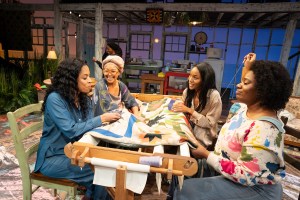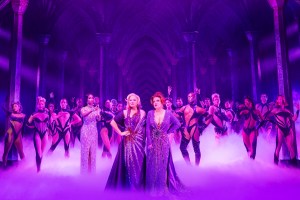An Inspector Calls at the Shakespeare Theatre
J.B. Priestley’s mystery is revived with Stephen Daldry’s award-winning staging.

(© Photo by Mark Douet)
The touring revival of this avant-garde take on a post-World War II detective drama finds current cultural relevance, especially for politically minded Washington, DC audiences. Playwright J.B. Priestley was a highly notable figure, known as a spiritual predecessor to British mystery writers like Agatha Christie and P.D. James. He wrote mystery plays between the World Wars, but by the late 1950s his plays began to feel a bit stodgy, and An Inspector Calls fell out of production favor until director Stephen Daldry revived it with an edgy, postmodern flavor at the National Theatre in London in 1992.
The current production, now running at the Shakespeare Theatre, is a remount of that award-winning staging, with incredible set design including a dollhouse-like structure that audiences watch crack apart (physically and metaphorically), and a rainstorm and fog that permeate the stage and signal impending doom for its characters.
An Inspector Calls begins with a playful scene of children exploring the curtain, and then the set as it's revealed to the audience, but the main drama of the play focuses on the wealthy Birling family as they celebrate their daughter Sheila (Lianne Harvey) and her engagement to Gerald (Andrew Macklin). Breaking up their jovial evening is Inspector Goole (Liam Brennan), who has come to announce the death of a lower-class young woman. Initially, the family drunkenly chides the inspector for interrupting their celebration over the suicide of a stranger, but then the evening takes a turn as the Inspector begins to interrogate each family member and their awful truths and connections to this deceased woman pour out.
The dry humor of the cast is pitch perfect, but Christine Kavanagh as Mrs. Birling and Harvey's portrayal of Sheila are particularly spot-on. They both have a really deadly combination of willful ignorance and righteous indignation only gained by their elevated status. Aside from Goole, while the men of the family work themselves into an aggravated tizzy, the women steal the show with their captivating emotional highs and lows.
The biggest scene-stealer of all is the set design by Ian McNeill. There's a true moment of shock and awe as the heavy curtain rises to reveal not only the elements of weather onstage but a giant house teetering precariously above what looks almost like the crater from a bomb. Initially, the actors playing the Birlings tower within the house, similar to Alice when she eats the cake in Wonderland, but when the Inspector arrives, the house opens up like a music box. While this at once imposing and flimsy house could be a heavy-handed metaphor for the play's chastising message, the design is just so captivating that the message is really secondary to the visceral feelings it evokes just witnessing it. It's a true masterpiece in and of itself.
Besides the sheer awe of the set, the actors' glee and enjoyment of the mustache-twirling and high melodrama of the classic text is infectious. The real avant-garde portion of the show — a modern-dance-like moment with the children at the beginning — feels extraneous, but is also a nice, light tease before getting thrown into the drama of the play. Only after the big denouement — when the pacing starts to drag and the messaging feels a bit too unwieldy and repetitive — are we reminded that all the modern theatrical ingenuity still can't solve all the problems of a dated play. Luckily, the play's message, however obvious — that the 1 percent is culpable for atrocities that happen to the other 99 percent even if they themselves didn't cast the killing blow — still resonates today, and it comes across clearly enough in this production to make a real emotional impact.










